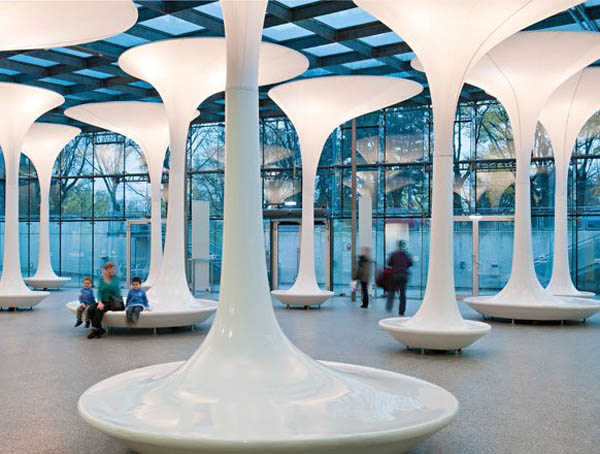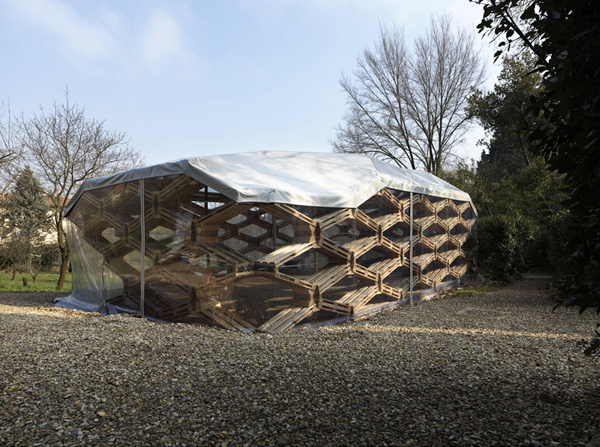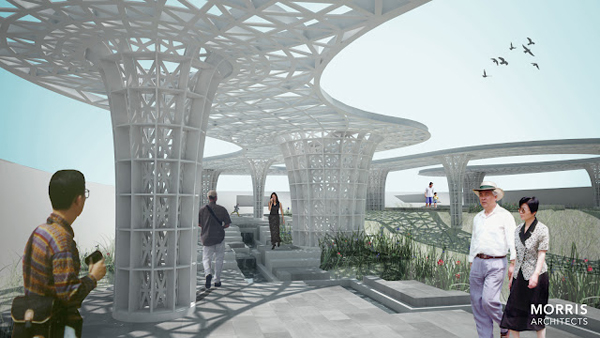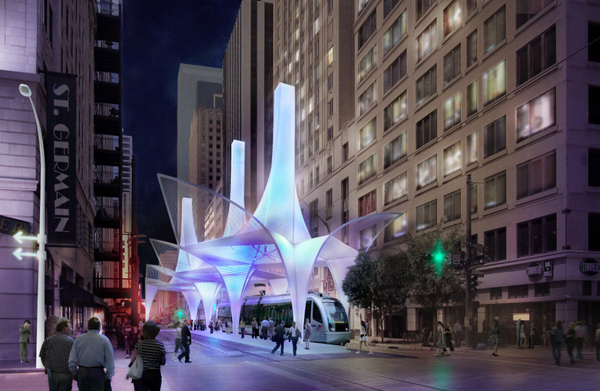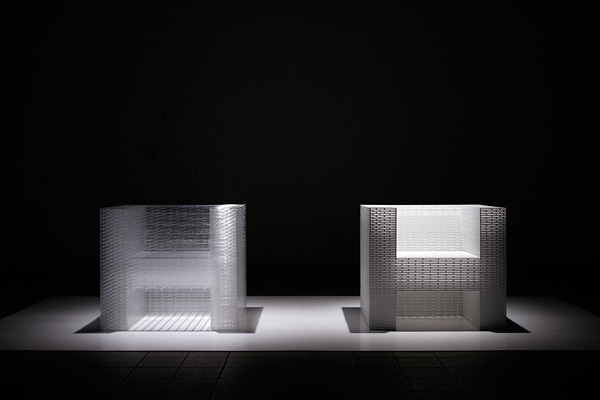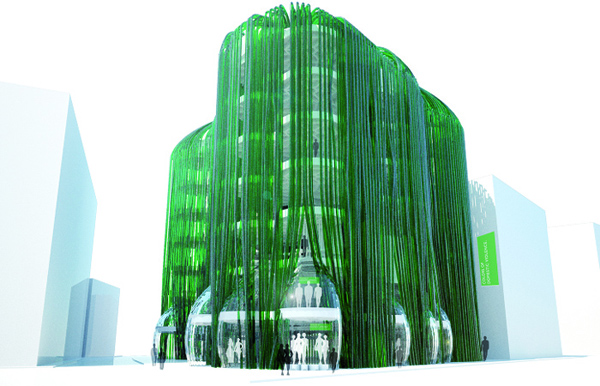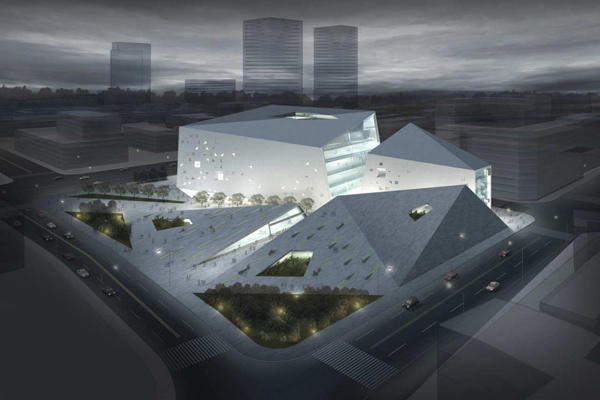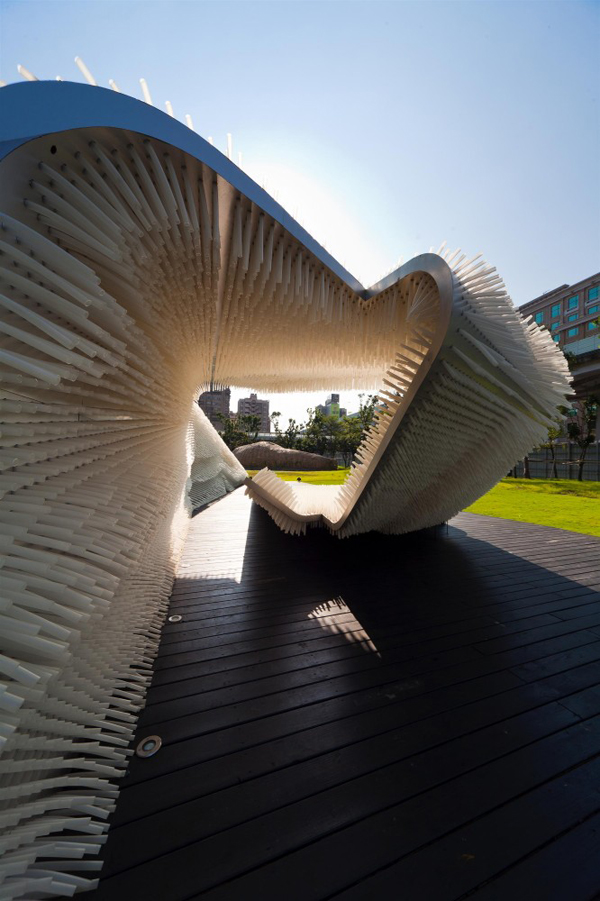American designer Stuart Fingerhut has created the Kinema Pendant Luminaire. This 10″ x 12″ x 14″ lighting object uses a combination of different layers in order to create a specific effect and appearance. The luminaire is unique in its ability to give the user control of the light’s character to match the mood of the environment. Each of the pendant’s rings can be individually flipped to create dramatic light and shadow effects, as a single object or in multiples. The designer states he was inspired by the movement of crustaceans; a wide variety of forms can be created by arranging the pendant’s rings in alternating open and closed positions. Read the rest of this entry »
Kinema Pendant Luminaire / Stuart Fingerhut
TMW Technical Museum Entrance Foyer / Querkraft Architects
Querkraft Architects, together with the Technical Museum of Vienna, designed a new entrance foyer and shop for the existing building. Older museum buildings are challenged to expand and modernize whilst remaining attached to their existing historical structures. In the 90s the technical museum faced precisely this difficulty as it tried to gain more space for a larger entrance foyer, a new museum shop and café as well as sufficient amenities, cloakroom space and ticketing capacity. The architectural solution that was chosen in the 90s was a steel-glass box placed in front of the existing historical structure. This solution proved problematic on a few levels shortly after the opening in 1999. The foyer was dominated by large temperature fluctuations, poor acoustics and ventilation, as well as less than optimal visitor circulation. Read the rest of this entry »
University of Applied Arts Vienna / Wolfgang Tschapeller
Located between 1st and 3rd district on the Ringstrasse in Vienna, a block of three cultural buildings presents an architectural whole with all parts maintaining their physical autonomy. The buildings are intended to house the content of the Museum for Applied Arts and partly accommodate the University of Applied Arts. Winning the competition for the reconstruction and linkage of the existing buildings, Wolfgang Tschapeller’s design seeks not only to restore the architecture, but also to reinvigorate the urban tissue of the site. Read the rest of this entry »
Recycled Pallet Pavilion / Avatar Architettura
Avatar Architettura is a multi-disciplinary Italian office for architecture and industrial design founded in 2001 by Nicola Santini and Pier Paolo Taddei. The office research is oriented towards the identification of design strategies which privilege ecology, flexible systems, biodiversity and recycled materials in urban context. Their Recycled Pallet Pavilion is a temporary structure acting as a versatile art space. It can host different kinds of events and offers space for a wide diversity of production forms. Read the rest of this entry »
Houston Pavilion for the 8th China International Garden Expo
Invited to participate in the 8th China International Garden Expo under the title “Better Garden, Better City”, the city of Houston appointed Morris Architects, along with SWA Group to design the Houston Pavilion. The design evokes the configuration of “bayous”, a network of slow-moving waterways dominating the cost of Gulf of Mexico.
The Houston pavilion is bounded by an embossed concrete wall that refers to the long Chinese tradition of walled gardens; the wall is inflected to allow entry and to retain an earthen hill that is intended to reference the topography of a Houston bayou. Visitors move along a path guided by a water course that winds between the perimeter wall and the hillside. The path is further defined by a trellised canopy to provide shade and to refer to the natural tree canopy of a typical bayou landscape. The trellised canopy is made up of plasma-cut plate steel, welded and painted white, covered by a perforated steel layer that will produce intricate patterns of shadows along the path. The hill is planted densely with indigenous grasses and wildflowers. Read the rest of this entry »
Design Proposals for Houston Central Station
The Houston Central Station Competition called for an iconic landmark station situated on the median strip on Main Street, between Capitol and Rusk. Here are the proposals of five award winning firms:
The proposal designed by ShoP Architects references the form of traditional train stations: columns supporting vaulted ceilings, lofted spaces that conjured images of grandeur, a firmness and solidarity that resonated with its surroundings. The tent like structure stretches beyond the platform, encompassing the surrounding urban space, thus breaking free from the restrictive narrow site. The 100 foot solar chimneys provide relief from heat, offer natural ventilation, helping air circulation. The form of the chimneys directs the rainwater so it wouldn’t disrupt the passenger flow.
Neil M. Denari Architects offered a steel structure; the concept was derived from the prevalent steel buildings of Houston, particularly Mies van der Rohe’s Museum of Fine Arts. The use of color evokes the surrounding icons of art and architecture, including sculptural works by Calder and even the George R. Brown convention center a few blocks away. Structure, signage, ticketing, lighting and seating are integrated and pertain to the single unique design gesture. Read the rest of this entry »
2450 White/Clear Chair Made of Acrylic Sticks
The chair is made up of 2450 acrylic sticks, each stick measuring only 5 mm. Glued together, they transform into an evocative structure that maintains a visual fragility but is a robust and functional chair that supports almost any weight. Designed by Japanese designer Junpei Tamaki, the seating structure appears fragile and delicate in its translucency, but also functional and stabile, with its rectangular form and massing. Depending on the light, it seems solid. However, on closer inspection, a pattern of acrylic segments is revealed. Read the rest of this entry »
Algae Urban Farm / ecoLogicStudio
The project seeks to provide the Benetton Group with a site specific building prototype able to give material consistence to such a renewed model. It is designed by ecoLogicStudio, a firm mostly oriented towards combining new computational technologies with natural principles and ecosystem processes. The initial idea for the project was found in the “recycling” of past Iranian architectural models and prototypes that are still deeply rooted into the culture of the place and are, at the same time, providing solutions that perfectly fit local microclimatic conditions. However the contemporary business models demand an architectural and material reinvention of those traditional models to accommodate the new spatial and per-formative requirements as well as communication/ branding potentials.
The main local models recycled in the project are: the geometric Islamic patterns and ornaments, employed as organizational principles for the plan, facade and structural systems; passive cooling techniques, turned into an innovative system of solar control and screening as well as passive ventilationand ground cooling; thermoregulatory systems using the thermal mass of the building envelope and the ground, reinvented in a new “deep facade” system using water as thermal storage and heat regulator. Read the rest of this entry »
MoMA Chengdu / Studio Ramoprimo
Organized by the Chengdu Ministry of Culture and the Chengdu Culture and Tourism Development Group, the Competition for the Chinese MoMA was part of an initiative for creating a double ring of public facilities around the Tianfu Square in Chengdu. The first ring is supposed to consist of cultural facilities. The second and larger one is planned for highrises.
Designed by Studio Ramoprimo, the winning entry proposes a dialogue with the surrounding, drawing physical references from the existing urban and architectural condition. The basic idea is to enlarge the existing public space of Tianfu Square and make it “climbing” on the roof of the new building. The new museum is a group of volumes creating a small cultural city. Read the rest of this entry »
Anemone Installation / Oyler Wu Collaborative
Anemone is an art installation aimed at waving together aesthetic experience and tactile engagement- a combination generally considered off limits within the world of contemporary art. All too often, art installations are considered precious, almost sacred objects; while they are meant to be appreciated for their aesthetic beauty, they offer little in terms of human interaction. In other words, they are meant to be seen, not felt. Recognizing that human engagement is one of the key factors in creating a rich experience, Anemone has been designed with the idea of interaction as one of its key design objectives. Read the rest of this entry »


